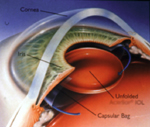It's not your mom's cataract surgery anymore
by Dick PetersonPublic Relations
When mom had cataract surgery—or maybe it was grandma—she probably was hospitalized for about two weeks and had to lie perfectly still with her head immobilized between sandbags until the sutured incision in her cornea healed. Then she wore glasses so thick they looked like they had been removed from the sight holes of an armored car.
If that’s your view of today’s cataract surgery, it’s about as clouded as mom’s cataracts.
“What we barely dared to dream about five to eight years ago is a reality today,” said ophthalmologist Kerry Solomon, M.D. He and David Vroman, M.D., both of the MUSC Storm Eye Institute, cheer the technological and clinical hurdles that in recent years have been overcome in cataract and refractive surgery.
“Everyone develops cataracts,” Vroman said, “all you have to do is live long enough. It’s part of the aging process.” But Vroman and Solomon see it as unnecessary in that process.
 The
cataract, the lens of the eye which has become clouded, is emulsified and
suctioned away. The lens is replaced by an intraocular lens, an IOL, that
unfolds from its triangular shape as it is inserted into the eye.
The
cataract, the lens of the eye which has become clouded, is emulsified and
suctioned away. The lens is replaced by an intraocular lens, an IOL, that
unfolds from its triangular shape as it is inserted into the eye.
Vroman described modern cataract surgery: “You enter the operating room in street clothes. We use drops to numb the eyes, and make a tiny incision in the cornea that will close and heal almost immediately after the cataract is removed.” That incision, he said, allows access to the clouded lens, the cataract, which is emulsified and suctioned away. The lens is replaced by an intraocular lens, an IOL, that unfolds from its triangular shape as it is inserted into the eye.
“It’s an in and out procedure, “ Solomon said. “It’s not extensive, and there’s no rehabilitation involved.”
He cited a cataract patient from the day before: “He flew in from Texas for the operation yesterday. We had dinner together last night and he is flying back home today.”
And remember that old saying that a cataract shouldn’t be removed until it’s “ripe?” “Forget it,” Vroman said.”When a cataract begins to affect your living, it’s time to have it removed.” If there’s too much glare to drive at night, if a cataract means you have to give up sewing or other close handwork, it’s time to have it removed.
As if the clinical advances in cataract surgery weren’t enough, Solomon touts “a silver lining” in the procedure. “We can treat nearsightedness, farsightedness and astigmatism while removing cataracts,” he said.
When the cataract is removed, the IOL, inserted in its place, can restore the patient’s eyesight to a normal 20-20. Even bifocal IOLs can be implanted.
“I’ve had patients tell me that cataract surgery was the best thing that ever happened to them,” Solomon said. “I call it the ‘wow’ effect, an instantaneous recovery of vision.”
Solomon’s ‘wow’ effect has become the experience of increasingly more patients as the fields of refractive surgery and cataract surgery join to become a more singular discipline. While people aged 60, 70 or 80 can experience the eyesight of younger people with improved IOLs implanted following cataract surgery, younger patients with poor vision but no cataracts can achieve the same results with refractive lens exchange, phakic lenses, LASIK (an acronym for a surgical procedure called Laser-Assisted In Situ Keratomileusis) or a combination of phakic and LASIK.
A refractive lens exchange is essentially the same as cataract surgery, but without the cataract. Instead of removing a clouded lens, the natural clear lens is removed and replaced by an IOL for refractive purposes. A phakic lens is an IOL implanted over an existing natural lens for refractive purposes. LASIK surgery reshapes the cornea, which is the clear outer surface of the eye, to change refractive qualities and improve vision. Solomon said that a combination of a phakic lens implanted over a natural lens, followed up with fine-tuning by LASIK surgery is needed for some patients.
“We’re treating people now who are outside the realm of LASIK surgery,” Solomon said. These are people who are not able to have LASIK, but can enjoy the benefits of LASIK—elimination of glasses and contacts—with the use of intraocular lenses.
Solomon said that MUSC’s Storm Eye Institute stays involved in all aspects of cataract and refractive surgery and works closely with industry in the research and development of innovative intraocular lens designs.
For more information about Storm Eye Institute’s cataract services or
to schedule an appointment, call 792-8100 or visit http://www.stormeye.org.
Friday, Jan. 21, 2005
Catalyst Online is published weekly, updated
as needed and improved from time to time by the MUSC Office of Public Relations
for the faculty, employees and students of the Medical University of South
Carolina. Catalyst Online editor, Kim Draughn, can be reached at 792-4107
or by email, catalyst@musc.edu. Editorial copy can be submitted to Catalyst
Online and to The Catalyst in print by fax, 792-6723, or by email to petersnd@musc.edu
or catalyst@musc.edu. To place an ad in The Catalyst hardcopy, call Community
Press at 849-1778.